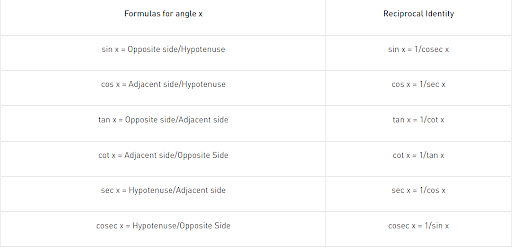Question:
If $ \tan \alpha =\frac{b}{a},a>b>0 $ and if $ 0
If $ \tan \alpha =\frac{b}{a},a>b>0 $ and if $ 0
Updated On: Apr 8, 2024
- $ \frac{2\sin \alpha }{\sqrt{\cos 2\alpha }} $
- $ \frac{2\cos \alpha }{\sqrt{\cos 2\alpha }} $
- $ \frac{2\sin \alpha }{\sqrt{\sin 2\alpha }} $
- $ \frac{2\cos \alpha }{\sqrt{\sin 2\alpha }} $
Hide Solution
Verified By Collegedunia
The Correct Option is A
Solution and Explanation
Given, $tan \, \alpha=\frac{b}{a},a>b>0 $
Now, $ \sqrt{\frac{a+b}{a-b}}-\sqrt{\frac{a-b}{a+b}} $
$=\frac{a+b-a+b}{\sqrt{a-b}.\sqrt{a+b}}=\frac{2b}{\sqrt{{{a}^{2}}-{{b}^{2}}}} $
$=\frac{2\frac{b}{a}}{\sqrt{1-{{\left( \frac{b}{a} \right)}^{2}}}} $
$=\frac{2\tan \alpha }{\sqrt{1-{{\tan }^{2}}\alpha }} $
$=\frac{2\frac{\sin \alpha }{\cos \alpha }}{\sqrt{\frac{{{\cos }^{2}}\alpha -{{\sin }^{2}}\alpha }{{{\cos }^{2}}\alpha }}}=\frac{2\sin a}{\sqrt{\cos 2\alpha }} $
Now, $ \sqrt{\frac{a+b}{a-b}}-\sqrt{\frac{a-b}{a+b}} $
$=\frac{a+b-a+b}{\sqrt{a-b}.\sqrt{a+b}}=\frac{2b}{\sqrt{{{a}^{2}}-{{b}^{2}}}} $
$=\frac{2\frac{b}{a}}{\sqrt{1-{{\left( \frac{b}{a} \right)}^{2}}}} $
$=\frac{2\tan \alpha }{\sqrt{1-{{\tan }^{2}}\alpha }} $
$=\frac{2\frac{\sin \alpha }{\cos \alpha }}{\sqrt{\frac{{{\cos }^{2}}\alpha -{{\sin }^{2}}\alpha }{{{\cos }^{2}}\alpha }}}=\frac{2\sin a}{\sqrt{\cos 2\alpha }} $
Was this answer helpful?
0
0
Top Questions on Trigonometric Functions
- The graph of a trigonometric function is as shown. Which of the following will represent the graph of its inverse?

- CBSE CLASS XII - 2025
- Mathematics
- Trigonometric Functions
- Solve for \( x \), \[ 2 \tan^{-1} x + \sin^{-1} \left( \frac{2x}{1 + x^2} \right) = 4\sqrt{3} \]
- CBSE CLASS XII - 2025
- Mathematics
- Trigonometric Functions
- Evaluate: $ \tan^{-1} \left[ 2 \sin \left( 2 \cos^{-1} \frac{\sqrt{3}}{2} \right) \right]$
- CBSE CLASS XII - 2025
- Mathematics
- Trigonometric Functions
- The integral \[ \int_0^\pi \frac{8x}{4\cos^2 x + \sin^2 x} \, dx \text{ is equal to:} \]
- JEE Main - 2025
- Mathematics
- Trigonometric Functions
- The value of \( \cos \left( \sin^{-1} \left(-\frac{3}{5}\right) + \sin^{-1} \left(\frac{5}{13}\right) + \sin^{-1} \left(-\frac{33}{65}\right) \right) \) is:
- JEE Main - 2025
- Mathematics
- Trigonometric Functions
View More Questions
Questions Asked in KEAM exam
- A lift having mass 1000kg moves upward against a frictional force of 2000N. Power given by motor is 36000W. What is the velocity of the lift?
- KEAM - 2025
- Speed, Time and Distance
- Solve for \( a \) and \( b \) given the equations: \[ \sin x + \sin y = a, \quad \cos x + \cos y = b, \quad x + y = \frac{2\pi}{3} \]
- KEAM - 2025
- Trigonometry
- If \( A \) is a \( 3 \times 3 \) matrix and \( |B| = 3|A| \) and \( |A| = 5 \), then find \( \left| \frac{\text{adj} B}{|A|} \right| \).
- KEAM - 2025
- Matrix Operations
- An unbiased die is tossed until a sum \( S \) is obtained. If \( X \) denotes the number of times tossed, find the ratio \( \frac{P(X = 2)}{P(X = 5)} \).
- KEAM - 2025
- Probability
- If $ f(x) = \log 3 - \sin x $, $ y = f(f(x)) $, find $ y(0) $.
- KEAM - 2025
- Functions
View More Questions
Concepts Used:
Trigonometric Functions
The relationship between the sides and angles of a right-angle triangle is described by trigonometry functions, sometimes known as circular functions. These trigonometric functions derive the relationship between the angles and sides of a triangle. In trigonometry, there are three primary functions of sine (sin), cosine (cos), tangent (tan). The other three main functions can be derived from the primary functions as cotangent (cot), secant (sec), and cosecant (cosec).
Six Basic Trigonometric Functions:
- Sine Function: The ratio between the length of the opposite side of the triangle to the length of the hypotenuse of the triangle.
sin x = a/h
- Cosine Function: The ratio between the length of the adjacent side of the triangle to the length of the hypotenuse of the triangle.
cos x = b/h
- Tangent Function: The ratio between the length of the opposite side of the triangle to the adjacent side length.
tan x = a/b
Tan x can also be represented as sin x/cos x
- Secant Function: The reciprocal of the cosine function.
sec x = 1/cosx = h/b
- Cosecant Function: The reciprocal of the sine function.
cosec x = 1/sinx = h/a
- Cotangent Function: The reciprocal of the tangent function.
cot x = 1/tan x = b/a
Formulas of Trigonometric Functions:
